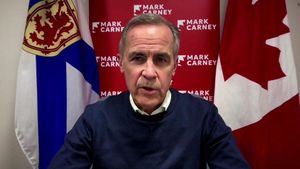On Saturday, February 1, 2025, Indian Finance Minister Nirmala Sitharaman presented the Union Budget 2025, heralding major revisions to income tax slabs aimed at providing relief to the middle class amid rising inflation. The newly proposed tax structure exempts individuals earning up to ₹12 lakh from any income tax, marking the biggest tax relief initiative in over a decade.
This bold move is part of the government’s strategy to combat high inflation and slow consumer demand, which has been particularly detrimental to urban households. Sitharaman's announcement is seen as a direct response to faltering economic growth, which is expected to reach its lowest point in four years.
Under the new system, individuals with annual incomes up to ₹4 lakh will pay no tax, with incremental tax rates applied until incomes over ₹24 lakh are taxed at 30%. Specifically, the new income tax slabs are structured as follows:
- 0 to ₹4 lakh - Nil
- ₹4 lakh to ₹8 lakh - 5%
- ₹8 lakh to ₹12 lakh - 10%
- ₹12 lakh to ₹16 lakh - 15%
- ₹16 lakh to ₹20 lakh - 20%
- ₹20 lakh to ₹24 lakh - 25%
- Above ₹24 lakh - 30%
This shift allows for significant tax savings for many citizens. For example, individuals with income up to ₹12 lakh, who previously faced tax liabilities around ₹80,000, will now bear no tax burden due to the introduction of rebates and adjustments effective this fiscal year. Finance Secretary Tuhin Kanta Pandey expressed optimism, stating, “The tax cuts would lead to higher consumption, savings, and investments, stimulating the economy decisively.”
Industry experts note the potential for the tax cuts to invigorate consumer spending, particularly as disposable incomes rise. “Taxpayers earning 2.5 million rupees will now save approximately 343,000 rupees annually, effectively putting more money back in their pockets,” highlighted Adhil Shetty, CEO of BankBazar.com.
Despite these optimistic measures, concerns linger over the broader economic picture. The government anticipates losing around 1 trillion rupees per year due to these tax reductions, which may cause apprehension among analysts about balancing fiscal prudence with stimulating growth. Importantly, the tax concessions are expected to benefit only the 1.6% of Indians who currently pay direct taxes—approximately 22.4 million individuals.
The budget also emphasizes infrastructure spending, which remains pivotal for economic revival. The government has modestly increased its capital expenditure target for infrastructure projects, allocating 11.2 trillion rupees ($129.18 billion) for the year. Officials will provide interest-free loans to various states to shore up investments, thereby enhancing developmental initiatives.
Small and micro-industries, which constitute about 35% of India’s manufacturing sector, are also slated for support through fiscal allocations of 1.5 trillion rupees over five years. Meanwhile, regulatory reforms are poised to streamline processes and reduce the compliance burden on businesses, according to Sitharaman, who described the initiative as pivotal for enhancing the ease of doing business.
While addressing the budget, she stated, “The aim is to benefit the middle class without letting higher incomes escape taxation.” This statement underpins the brilliance behind this budget strategy—boosting spending power among lower earners potentially stimulates economic growth.
To determine the rate changes under this new regime, taxpayers may adopt either the new or legacy tax systems. The legacy system provides exemptions for housing rents and insurance, creating complexity for some taxpayers deciding which path is more advantageous. The new system, introduced in 2020, promises simplified tax rates without major exemptions.
Looking forward, the government has reiterated its commitment to fiscal discipline by targeting a deficit reduction from 4.8% to 4.4% by 2026. The Reserve Bank of India's recent decisions could align with these objectives as the central bank prepares to ease monetary policies, contemplating rate cuts to support growth as inflation begins to stabilize.
Experts caution, though, against over-reliance on tax cuts as the fix-all solution. “The impact on widening the tax base is limited since only about 73 million out of nearly one billion taxpayers are engaged actively,” said Aurodeep Nandi, India Economist at Nomura. Still, the optimism surrounding awakening consumer spirits remains palpable, with the market reacting positively, particularly stocks linked to consumer goods and automobiles rallying shortly after the announcement.
The Union Budget 2025 not only highlights the government’s tactical maneuvers to address immediate economic challenges but also lays the groundwork for more long-term reforms. While the measures introduced aim to invigorate the economy, the management of fiscal and economic health remains key as India navigates these turbulent waters toward recovery.



